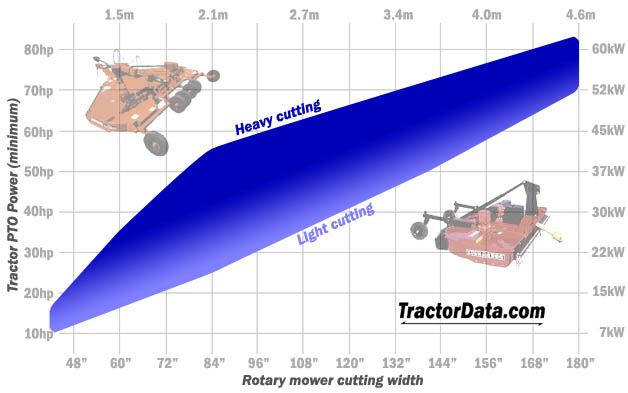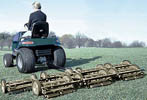Tractor Mowing
Mowing is a common use for tractors. From cutting hay or managing over-grown fields to manicuring lawns, a wide variety of mowers can be used to meet the needs of the job.
Power and mower size
The tractor power needed is determined by the size of the mower, the type of mower, and heavy the grass is. Larger mowers, thick or long vegetation, and wet grass will require more power. Mower manufacturers will recommend a specific tractor power requirement for their mowers. In addition, many tractor manufacturers can recommend specific mowers matched to their tractors. The chart below is a general guide to power requirements for rear-mounted rotary mowers

 Rotary mowers consist of one or mower blades which rotate perpendicular to the surface being cut. The blades cut and tear the vegetation as they spin. A rotary mower may be mounted behind the tractor, or below the tractor frame (as with riding lawn mowers). Some people refer to heavy-duty rotary mowers as 'bush hogs', although Bush Hog is actually the brand name of an equipment manufacturer with a history of making heavy-duty rotary mowers.
Rotary mowers consist of one or mower blades which rotate perpendicular to the surface being cut. The blades cut and tear the vegetation as they spin. A rotary mower may be mounted behind the tractor, or below the tractor frame (as with riding lawn mowers). Some people refer to heavy-duty rotary mowers as 'bush hogs', although Bush Hog is actually the brand name of an equipment manufacturer with a history of making heavy-duty rotary mowers.
Finishing mowers are a type of rotary mower used to provide a well-groomed field of grass. Finishing mowers use a lower cutting height than general rotary mowers and may be equipped with bagging systems or discharge chutes to control disposal of the cut grass.
 Reel mowers use a series of blades mounted in a cylindrical shape to cut grass against stationary blade. Reel mowers were the first mower design and produce a very fine cut due to the scissor action of the blades (rotary mowers tend to tear grass more than cut it). For this reason, reel mowers are frequently used on golf courses, sports fields, and other locations that need a high-quality finish on the grass. Gangs of reel mowers are pulled by tractors to cut large areas. The mowers can be ground-driven and simply towed, or they may be powered from the tractor's PTO.
Reel mowers use a series of blades mounted in a cylindrical shape to cut grass against stationary blade. Reel mowers were the first mower design and produce a very fine cut due to the scissor action of the blades (rotary mowers tend to tear grass more than cut it). For this reason, reel mowers are frequently used on golf courses, sports fields, and other locations that need a high-quality finish on the grass. Gangs of reel mowers are pulled by tractors to cut large areas. The mowers can be ground-driven and simply towed, or they may be powered from the tractor's PTO.
Flail mowers use a series of chains or metal knives (flails) mounted to a fast-rotating shaft. Flail mowers are less likely to throw debris than rotary mowers, making them a good choice to roadside or municipal work near people and vehicles. When equipped with the proper flails these mowers can also handle wet and thick vegetation, including crop debris or tree limbs.
Sickle mowers consist of a long bar of cutting teeth that move laterally across a set of stationary guard plates. The reciprocating action cuts the grass in an action similar to an electric razor. Sickle mowers have a long history, dating back to horse-drawn models that were powered by ground wheels.
Overrunning PTO Clutch
A significant safety concern when using a mower with a tractor is to have an overrunning clutch on the power-takeoff (PTO). An overrunning clutch is a mechanical device that allows the PTO shaft to be driven by the tractor, but not the implement attached to it. Without this device, the intertia of the spinning mower blades may "drive" the tractor forward even after the operator has depressed to clutch to stop.
